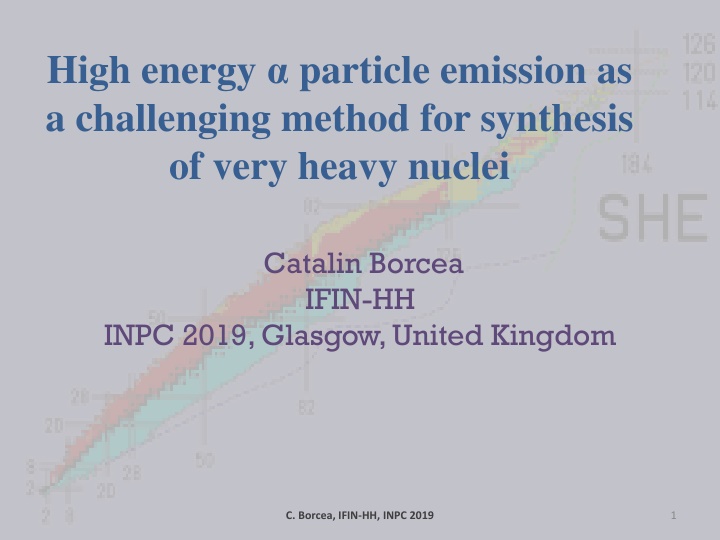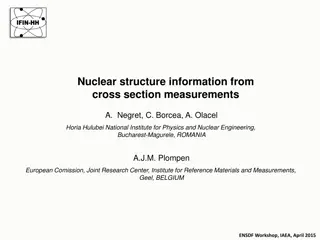
High Energy Particle Emission for Synthesis of Heavy Nuclei by Catalin Borcea at INPC 2019
Explore the challenging method of high-energy particle emission for synthesizing very heavy nuclei, as discussed by Catalin Borcea at INPC 2019 in Glasgow, United Kingdom. The research delves into super-heavy elements, experimental methods, limitations, and challenges in the field, aiming to refine approaches and reach the island of stability.
Download Presentation

Please find below an Image/Link to download the presentation.
The content on the website is provided AS IS for your information and personal use only. It may not be sold, licensed, or shared on other websites without obtaining consent from the author. If you encounter any issues during the download, it is possible that the publisher has removed the file from their server.
You are allowed to download the files provided on this website for personal or commercial use, subject to the condition that they are used lawfully. All files are the property of their respective owners.
The content on the website is provided AS IS for your information and personal use only. It may not be sold, licensed, or shared on other websites without obtaining consent from the author.
E N D
Presentation Transcript
High energy particle emission as a challenging method for synthesis of very heavy nuclei Catalin Borcea IFIN-HH INPC 2019, Glasgow, United Kingdom C. Borcea, IFIN-HH, INPC 2019 1
Outline Super-Heavy Elements (SHE): The status Spectra of light particle emission in heavy-ion induced reactions at incident energy <10 MeV/A: implications for the SHE research Necessary developments of the experimental methods Conclusions C. Borcea, IFIN-HH, INPC 2019 2
SHE: The status Z=113, 114, 115,116,117,118, 120? S. Hofmann et al., Eur. Phys. J. A 52 (2016) 180 C. Borcea, IFIN-HH, INPC 2019 3
The limitations: The use of 48Ca as primary beam (doubly magic, large neutron excess, tightly packed, highest observed cross sections) practically exhausted its potential Radioactive targets used: 240,242,244Pu, 243Am, 245,248Cm, 249Bk, 249Cf, 254Es, 257Fm will be very difficult The available combinations lead mostly to neutron deficient nuclei (fusion-evaporation reactions) Odd nuclei preferred hindrance) Cross sections in the pb fb region (alpha emission C. Borcea, IFIN-HH, INPC 2019 4
The challenges: Use of neutron rich incident beams above 48Ca Increased dominating fission(FF) processes competition quasi-fusion with (QF)/fast the Get closer to the island of stability, precisely establishing its existence and position C. Borcea, IFIN-HH, INPC 2019 5 Refine the experimental approaches to
Spectra of light particle emission in heavy-ion induced reactions at incident energy <10 MeV/A: implications for the SHE research 40Ar + 232Th 268Sg+ @ 220 MeV 48Ca+238U 282Ds + @270 MeV C. Borcea et al., Proceedings of the International Symposium on Exotic Nuclei 2016, Kazan, Rusia C. Borcea et al., Nucl. Phys. A 351 (1981), 312-320 C. Borcea, IFIN-HH, INPC 2019 6
Keywords: Collinear (0 ) Two-body : A+B C+D (masses, incident energy) Kinematic limit (KL): zero residual excitation energy Residual excitation energy controlled by energy No other reaction channel(s) possible close to KL Incident energy slightly above the barrier Targets: emitters Miscellaneous: - p, n also emitted but with lower cross C. Borcea, IFIN-HH, INPC 2019 7
Implications for SHE synthesis As product complementary to (two body reactions only) Close to 0 excitation energy (E*), controllable by the recorded alpha energy E* ~ 6 MeV 1n evaporation channel opens with substantially higher cross section Access to more n-rich nuclei Access to higher Z projectiles (to be measured) C. Borcea, IFIN-HH, INPC 2019 8
Theoretical model? A real challenge! Previous attempts (VZ, VB) Momentum transfer across the nucleus (analogy to the Newton s pendulum) Fast propagation of momentum (speed of sound in nuclear matter) Extra push (higher incident energy than in F-E reactions but lower excitation energy) C. Borcea, IFIN-HH, INPC 2019 9
New experimental developments Proof of principle: aiming to produce a known nucleus using a classical approach-GFS and compare the cross section: 40Ca+232Th 268Hs + ; T1/2H.R.=0.4 s Measurement of the particle spectra for different projectiles and incident energies around the coulomb barrier for optimizing the cross section at KL Coincident measurements heavy residue- particle will eliminate the necessity of having a link to the known isotope (unambiguous identification) Mass measurements possible (preliminary!) C. Borcea, IFIN-HH, INPC 2019 10
WHY NOT YET SEEN? The 48Ca+238U example: Incident energy: FE: 240 MeV, alpha: 270 MeV Compound excitation: 40 MeV (4-5n evap.) Heavy residue after alpha emission: close to zero or controlled by alpha excitation energy Much lower energy for heavy residue and a different mass (momentum conservation) Large difference in velocity: close to 20% more for F-E and correspondingly for C. Borcea, IFIN-HH, INPC 2019 11
Conclusions The solution of forwardly emitted high energy particle may open a new possibility for SHE synthesis that deserves to be tested. Possible use of beams above 48Ca. This method could also be used to obtain information for the empty cases of elements above Z=100 (production, mass and decay properties) with the benefit of higher cross section Allows access to more neutron rich nuclei C. Borcea, IFIN-HH, INPC 2019 12 Improvements of the identification methods will be
Thank you! C. Borcea, IFIN-HH, INPC 2019 13

